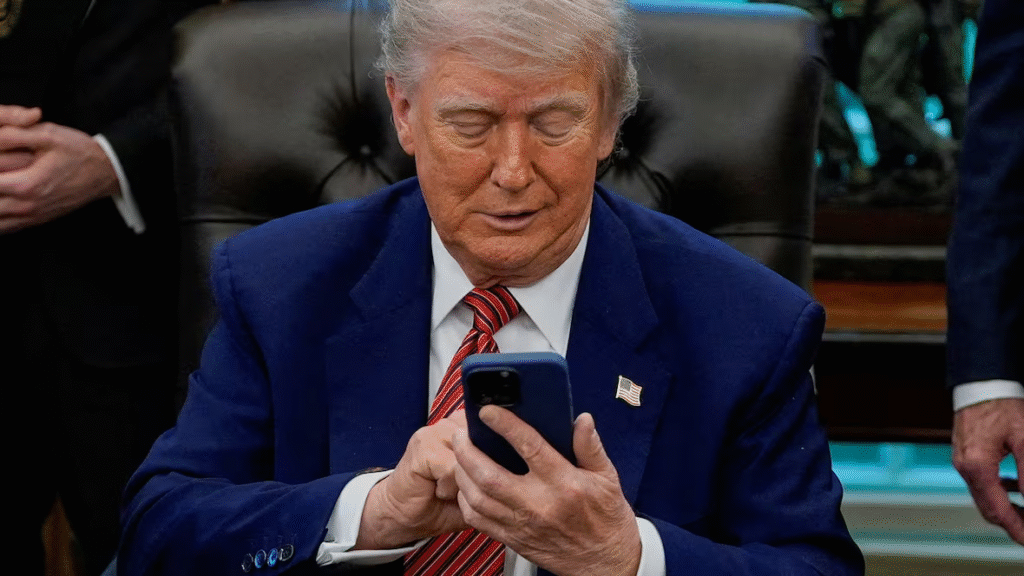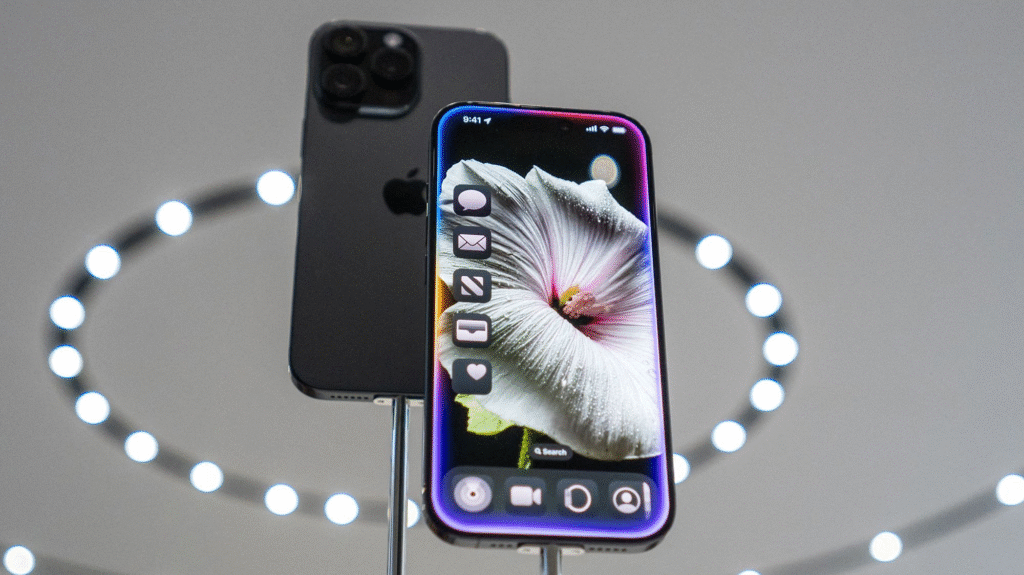Trump Threatens 25% Tariff on iPhones and Other Smartphones
On May 23, 2025, U.S. President Donald Trump announced a potential 25% tariff on iPhones sold in the U.S. if they are not manufactured domestically.
The warning, posted on Trump’s Truth Social platform, targeted Apple specifically but later expanded to include other smartphone makers like Samsung. This move is part of Trump’s broader push to bring manufacturing back to the U.S. The threat has rattled markets, with Apple’s stock dropping 3% on the same day.

Trump’s statement singled out Apple CEO Tim Cook, noting he had “long ago” informed Cook that iPhones sold in the U.S. must be made in the country.
In a later Oval Office press conference, Trump clarified that the tariff would apply to “Samsung and anybody that makes that product,” emphasizing fairness. The proposed tariffs could start by the end of June 2025, escalating trade tensions and raising concerns about higher consumer prices.
Background of Trump’s Tariff Push
Trump’s tariff threats are rooted in his “America First” economic policy, which aims to boost U.S. manufacturing and reduce reliance on foreign production. During his first term, Trump imposed tariffs on Chinese goods, prompting companies like Apple to diversify their supply chains.
His latest move targets not only China but also countries like India, where Apple has shifted much of its iPhone production. The president argues that foreign manufacturing hurts American workers and that tariffs will incentivize companies to build factories in the U.S.
The U.S. currently lacks large-scale smartphone manufacturing facilities, making Trump’s demand challenging. His administration believes tariffs will create jobs and stimulate economic growth.
Commerce Secretary Howard Lutnick has echoed this, stating that tariff-free production in the U.S. could usher in a “golden age” of manufacturing. However, critics warn that such tariffs could increase consumer prices and disrupt global supply chains.
Trump’s focus on Apple follows earlier tariff threats against companies like Walmart and Mattel, showing a pattern of targeting major U.S. firms with overseas operations.
The smartphone industry, with its complex global supply chains, is a high-profile target due to its economic significance and visibility. Apple alone accounts for a massive share of U.S. smartphone sales, making it a key player in this trade battle.
Why Trump Issued This Warning
Trump’s tariff threat is driven by both economic and political motives. Economically, he wants to reduce the U.S. trade deficit and revive domestic manufacturing.
The U.S. imports over 60 million smartphones annually, yet none are mass-produced domestically. Trump sees this as a missed opportunity for job creation. By targeting Apple and Samsung, he aims to pressure tech giants into building U.S. factories, which he claims will create “trillions” in economic activity.

Politically, the tariff threat reinforces Trump’s image as a tough negotiator fighting for American workers. His base supports policies that prioritize U.S. jobs, and targeting high-profile companies like Apple garners attention. However, some analysts question whether Trump can legally impose tariffs on individual companies, as U.S. trade law typically applies tariffs to countries or product categories, not specific firms.
Trump’s response—that the tariffs would apply broadly to all foreign-made smartphones—appears to address this concern.
The timing of the threat, just before the Memorial Day weekend, also reignited trade tensions with the European Union, which faces a separate 50% tariff threat starting June 1, 2025. Trump’s frustration with stalled EU trade talks and Apple’s shift to India suggests a broader strategy to reshape global trade dynamics.
Apple’s Official Response
Apple has not issued a detailed public statement directly addressing Trump’s latest tariff threat. The company declined to comment to Reuters, reflecting its cautious approach amid escalating trade rhetoric. However, Apple’s actions in recent years provide context for its stance.
CEO Tim Cook has emphasized the company’s contributions to the U.S. economy, including sourcing components from over 9,000 U.S. suppliers across all 50 states. In February 2025, Apple announced a $500 billion investment over four years in nine U.S. states, though this was focused on AI and data centers, not iPhone production.
On a recent earnings call, Cook noted that Apple faces a $900 million tariff-related cost this quarter, indicating the company is already grappling with trade challenges. He also highlighted Apple’s shift to India for iPhone production, stating that most U.S.-sold iPhones this quarter would originate there.
This move was meant to dodge tariffs on Chinese goods, but Trump’s latest threat undermines that strategy. Analysts doubt Apple can fully shift iPhone manufacturing to the U.S. within the next three to five years due to logistical and cost barriers.
Why Apple Manufactures Outside the U.S.
Apple’s decision to manufacture iPhones primarily in China, and increasingly in India, stems from cost, scale, and expertise. China offers a vast pool of skilled engineers and low labor costs, with roughly 85% of iPhone production still based there, according to Wedbush Securities. The country’s established supply chain, led by partners like Foxconn, allows Apple to produce millions of devices efficiently. Moving production to the U.S., where no large-scale smartphone factories exist, would require years and billions in investment.
India
Apple began expanding into India in 2017 to diversify from China amid U.S.-China trade tensions. By 2025, India accounted for over $17.4 billion in iPhone exports, with plans to make most U.S.-sold iPhones there by 2026. India’s growing manufacturing capabilities and lower costs compared to the U.S. make it an attractive alternative. Vietnam also plays a role, producing iPads, Macs, and other Apple products. These shifts reflect Apple’s need to balance geopolitical risks and maintain profit margins.
The U.S. lacks the infrastructure and workforce to support mass smartphone production. Building factories, training workers, and sourcing components domestically would likely raise iPhone prices significantly—potentially by $100 to $350 per device, according to Wells Fargo, or even up to $3,500, per other estimates. Apple’s late co-founder Steve Jobs once told former President Barack Obama that the U.S. simply doesn’t have enough skilled engineers for such operations, a challenge that persists today.
Impact and What’s Next
Trump’s tariff threat has sparked concern about rising smartphone prices and economic fallout. If implemented, the 25% tariff could force Apple to either raise iPhone prices or absorb the cost, hurting its margins. Samsung, with manufacturing in South Korea, Vietnam, India, and Brazil, faces similar pressures. Consumers could see iPhone prices jump from $1,200 to as high as $3,500, potentially dampening demand. Wall Street analysts like Wedbush’s Dan Ives call U.S.-based iPhone production a “fairy tale,” estimating a five- to ten-year timeline for such a shift.
The broader tech industry and global markets are also on edge. Apple’s stock drop erased over $100 billion in market value on May 23, signaling investor fears. The simultaneous 50% tariff threat on EU goods adds to global trade uncertainty.
While Trump’s past tariff threats have sometimes fizzled out, his focus on smartphones suggests a high-stakes gamble to reshape manufacturing.


 Trump Demands US Attorney General Share Epstein Data
Trump Demands US Attorney General Share Epstein Data  Trump Claims ‘Inflation Is Dead’ but June Surge Signals Otherwise
Trump Claims ‘Inflation Is Dead’ but June Surge Signals Otherwise  Has Trump Sided with Ukraine Over Russia in the War?
Has Trump Sided with Ukraine Over Russia in the War?  Trump Threatens Brazil with 50% Tariff Over Bolsonaro Trial
Trump Threatens Brazil with 50% Tariff Over Bolsonaro Trial  Trump Slaps Tariffs on Asian Nations, but India Secures Exemption
Trump Slaps Tariffs on Asian Nations, but India Secures Exemption